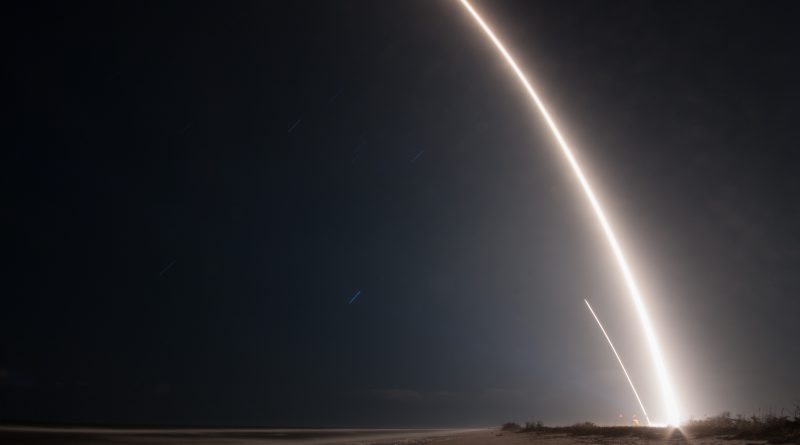Top-Secret Zuma Spacecraft Blasts Off on First SpaceX Mission of 2018
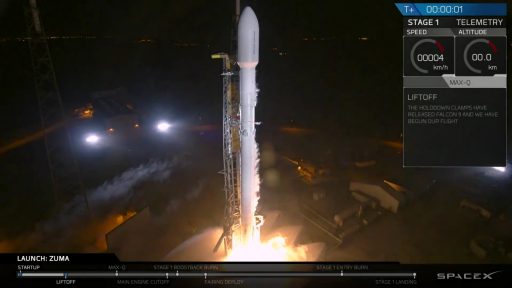
SpaceX’s Falcon 9 rocket lifted off from Florida’s Cape Canaveral under a veil of darkness Sunday night, both literally and figuratively with launch occurring at 1:00 UTC Monday morning, carrying into orbit the top-secret Zuma spacecraft which, from a public perspective, has all traits of a black project.
Embarking on its first flight of what is hoped to be another record-setting year, Falcon 9 climbed out from Cape Canaveral and swung to the north-east to dispatch the secretive Zuma spacecraft into Low Earth Orbit to what analysts suspect will be the same general neighborhood of the NROL-76 that puzzled satellite watchers last year and the Air Force’s X-37B that has been flying under the radar of the satellite tracking community for the last four months.
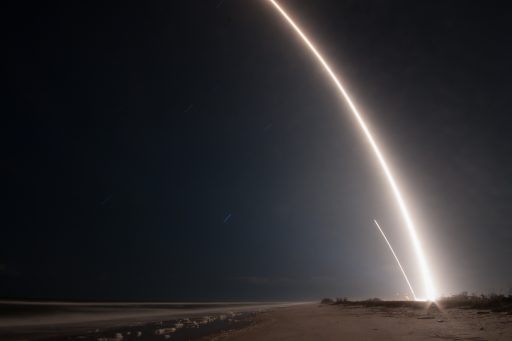
The two stages of SpaceX’s workhorse rocket parted ways two minutes and 24 seconds into the flight as the first stage headed back to Cape Canaveral and the MVac-powered second stage fired up to deliver Zuma to its orbital destination which, per analysis of available information, could be anywhere between 300 and 1,000 Kilometers in altitude.
With the second stage entering a deliberate news blackout reminiscent of classified NRO satellite deliveries, the first stage made a rocket-powered U-turn maneuver to place itself on a path back to the launch site. A burn at re-entry slowed the stage down to create a benign flight environment through Earth’s atmosphere and the final landing burn using only the booster’s center engine managed to set the 47-meter tall vehicle down on its four landing legs, touching down at Landing Zone 1 less than eight minutes after taking off from Space Launch Complex 40 located some nine Kilometers north of the landing spot.
#SpaceX’s #Falcon9 rocket launches the classified #Zuma payload at 8pm and lands its first stage back at Cape Canaveral Air Force Station’s Landing Zone 1 shortly after in this three-image long exposure composite photograph taken from Cocoa Beach. pic.twitter.com/8LBrbZCoJa
— John Kraus (@johnkrausphotos) January 8, 2018
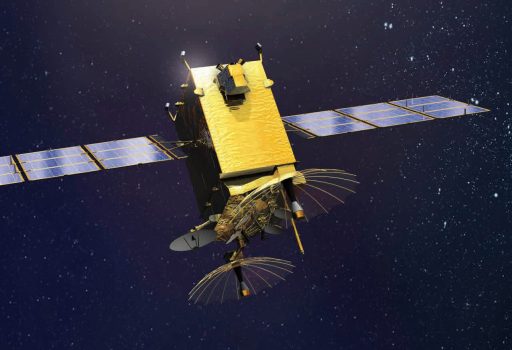
The most secretive U.S. space mission in recent memory came only with a few bits of public information after the launch showed up on SpaceX’s manifest only a month in advance when the California-based launch services provider filed regulatory documentation with the Federal Communications Commission. However, Zuma ended up slipping over seven weeks from its initial November 15 launch target due to potential concerns related to Falcon 9’s payload fairing – leading to a switch from LC-39A at the Kennedy Space Center to SLC-40 at Cape Canaveral Air Force Station.
It is understood that the need to launch the mission by the end of November was communicated to SpaceX around seven months in advance, the pressing reason being the need to hit revenue targets on the launch customer side.
Zuma, or ‘Mission 1390,’ was built by Northrop Grumman and was targeting a Low Earth Orbit. Its launch was procured by Northrop Grumman acting as primary contractor for an unnamed U.S. Government agency in a similar architecture as the NROL-76 satellite for which Ball Aerospace acted as prime spacecraft contractor and launch vehicle procurement agent while the NRO owned and operates the satellite.

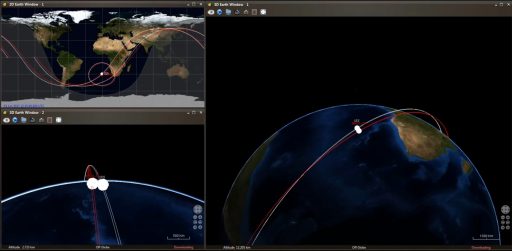
Pressed by Aviation Week, the National Reconnaissance Office went on the record to clarify that it does not own Zuma which indicates operation or exploitation will be handled by another three-letter agency possibly the NSA, NGA for DIA.
The secrecy surrounding Zuma’s launch is reminiscent of the PAN and CLIO missions launched in 2009 and 2014 that puzzled analysts at the time since Lockheed Martin came forward as the builder of the two satellites and even shared photos of the spacecraft in processing – previously unheard of for classified missions.
PAN and CLIO’s operators and mission objectives were never revealed but satellite trackers spotted the classified satellites parked in Geostationary Orbit close to foreign communications satellites – strongly indicating they were electronic intelligence satellites tasked with intercepting the uplinks to the satellites they were next to. This was later confirmed in Snowden Documents that showed PAN and CLIO to be under direct tasking by the NSA and CIA to provide “a site in the sky” to vacuum up communications to satellites that were out of reach for conventional intercept means.
While equally secretive and procured in the same way as PAN and CLIO, Zuma bears closer resemblance to NROL-76 that launched on Falcon 9 on May 1st, 2017. The satellite was spotted in a Low Earth Orbit of 400 Kilometers at an inclination of 50°.
On June 3rd, NROL-76 had a close encounter with the International Space Station, possibly coming as close as five Kilometers to the orbiting outpost that orbits just over 400 Kilometers in altitude at an inclination of 51.6 degrees. Analysis of the event showed that a number of random factors would have to align to create an orbital geometry such as this, raising the hypothesis of the close rendezvous being deliberate.
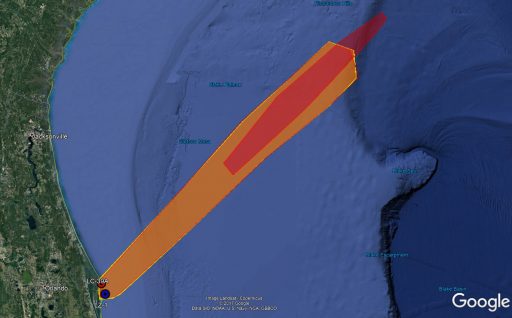
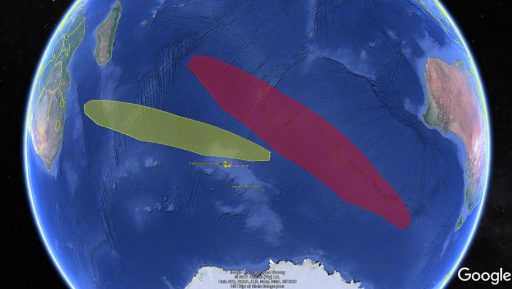
From the Launch Hazard Area and Notices to Airmen and Mariners issued for the Zuma mission, the two launches appear surprisingly similar:
The NOTAMs issued for the Western North Atlantic stretch from the Florida launch site to around 520 Kilometers downrange, revealing Zuma’s launch azimuth to be consistent with a 50-degree orbit (give or take a couple of degrees). A 5,500-Kilometer long and 950-Kilometer wide hazard area is in effect over the Southern Indian Ocean for 3:00 to 6:37 UTC for the deorbit of the second stage between two and three and a half hours after launch.
NROL-76 (USA 276) had fairly similar NOTAMed areas – the launch zone was in the same direction and stretched to around 450km downrange, but the second stage debris impact area was further west of that for Zuma, stretching from 38°E to 49°E while Zuma’s second stage debris zone is in effect from 63.5 to 125.5°E. Analysis of the geometry between the launch azimuth and second stage impact zones points to a difference in right ascension between Zuma and NROL-76 on the order of 8 degrees.
A number of mission profiles and orbits can be fitted with the constraining factors of the Zuma mission, notably the launch azimuth, launch window, second stage impact area and second stage deorbit time. The same was the case for NROL-76 and Falcon 9’s apparent performance surplus for these LEO missions could enable a number of moves that are difficult to predict such as plane change maneuvers and RAAN adjustments through a multi-burn profile.
In case a single-burn ascent profile is used for Zuma, as was the case for NROL-76, the prevailing solution seems to be a circular Low Earth Orbit between 300 and 500 Kilometers in altitude with an inclination around 50 degrees.
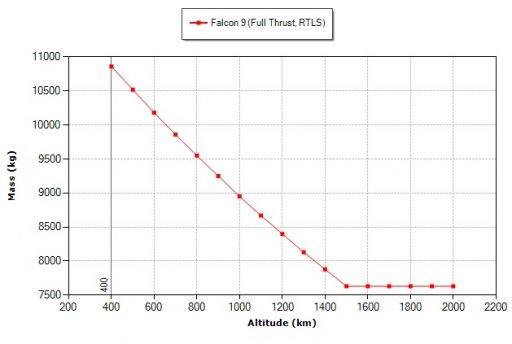
Satellite analyst Ted Molczan developed a possible solution for a three-burn mission into a higher orbit of 1,000 Kilometers inclined 52° that would also fit with the published second stage impact area. Falcon 9 has the performance to carry out any of these missions with room to spare: taking into account the RTLS of the first stage and second stage deorbit, Falcon 9 can lift well over seven metric tons into a 1,000km orbit.
With Zuma and NROL-76 heading into the same general area and the X-37B OTV-5 mission also flying in a higher-inclined orbit than its predecessors, an interesting case is emerging with several classified missions conducting secret business in Low Earth Orbit. NROL-76 was last reported in an orbit of 376 by 407 Kilometers; OTV-5 has not yet been conclusively identified in orbit since launching in September but it was stated the mission would be utilizing a higher inclination than previous X-37B missions that flew between 38 and 43.5° – putting it in the same ballpark.
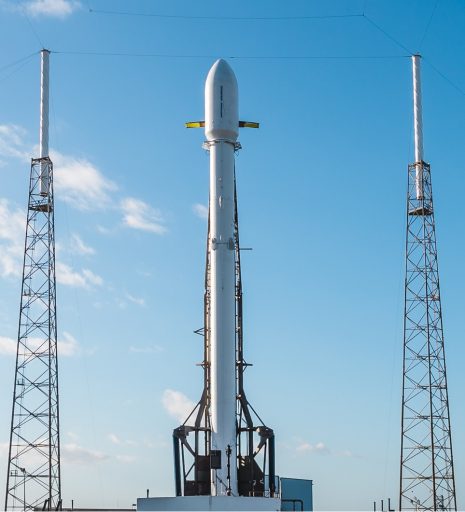
Another potential connection between NROL-76 and Zuma is the fact that Zuma’s launch requirement of November 1 through 30 was communicated to SpaceX in late April, just days before USA 276 took flight. However, while the orbital plane of NROL-76 would have been close to Zuma’s for the November 16 launch slot, there was quite a bit of planar separation for Sunday night’s launch (but the day-to-day slips encountered by Zuma over the course of the week helped bring them a bit closer together).
This could all very well be coincidental with several missions independently targeting orbits per their requirements and all three launching on SpaceX could be coincidence as well since the company has been the dominating force in the U.S. launch business over the last year.
The identity of the NROL-76 and Zuma missions and any connection between may become evident once Zuma’s orbit is known. A prevailing theory on NROL-76, based on the specialties of its manufacturer and hints dropped in the mission insignia, was a technology demonstration of a new type of reconnaissance payload in a USA 193-style mission with potential operational aspects since the non-synchronous, 50° orbit can provide favorable revisit patterns for the military hot spots of the day, North Korea being the leading example.
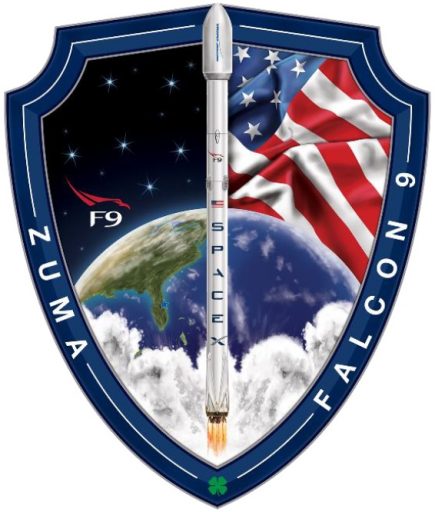 The flyby with ISS put the mission in a different light as theories branched out into two areas: NROL-76 could be a Space Situational Awareness demonstration using ISS as a sizeable target to test out sensors at very close range and different look angles during the initial rendezvous in June and wider range up to several hundred Kilometers during subsequent passes as the planar separation between the two increased. Another possibility, if NROL-76 is an operational mission, could be its use of ISS as a “shield” since any anti-satellite maneuver against USA 276 would create a dangerous debris population intersecting the Space Station’s orbit, coming with major political fallout.
The flyby with ISS put the mission in a different light as theories branched out into two areas: NROL-76 could be a Space Situational Awareness demonstration using ISS as a sizeable target to test out sensors at very close range and different look angles during the initial rendezvous in June and wider range up to several hundred Kilometers during subsequent passes as the planar separation between the two increased. Another possibility, if NROL-76 is an operational mission, could be its use of ISS as a “shield” since any anti-satellite maneuver against USA 276 would create a dangerous debris population intersecting the Space Station’s orbit, coming with major political fallout.
Should Zuma indeed enter a similar orbit as USA 276 it will be interesting to see whether the geometry between the two is shaped for close passes, pointing to a Space Situational Awareness objective between the two, or if their orbits are optimized for revisit over locations of interest in which case an operational mission like reconnaissance with two different but complementary sensors would be a possibility.
For SpaceX, Sunday night’s launch marked the end of a lengthy launch campaign that included the company’s first switch of launch pads after stacking of a vehicle. Re-located to SLC-40 in mid-December, Falcon 9 went through several propellant loading tests throughout the week while launch was on hold for upper level winds before completing integration with the classified payload and taking its vertical position by Sunday morning.
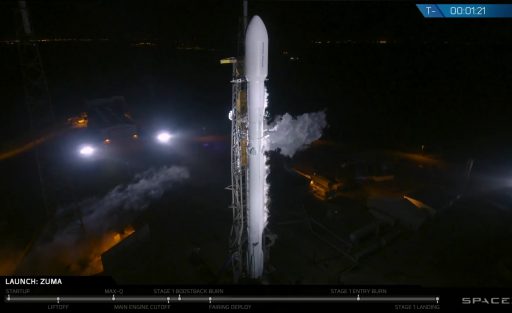
Checkouts performed in the early portion of the countdown awarded Falcon 9 a clean bill of health and weather was looking very favorable, allowing Falcon 9 to enter its automated countdown at T-70 minutes when chilled Rocket Propellant 1 started flowing into the two stage rocket. Sub-cooled Liquid Oxygen was pumped into the first stage starting at T-35 minutes and LOX load on the second stage started 15 minutes later to have Falcon 9 reach launch mass just in time for liftoff, holding over 500 metric tons of propellant.
The 70-meter tall rocket checked off the final critical countdown events inside T-7 minutes, beginning with the chilldown of its nine Merlin 1D main engines followed by the preliminary pressurization of tanks for the retraction of the Strongback, the transition to internal power and the completion of propellant loading right at the T-2 minute mark. Falcon 9 assumed control of the count at T-1 minute and the final go-aheads were given by the Eastern Range and Launch Director.
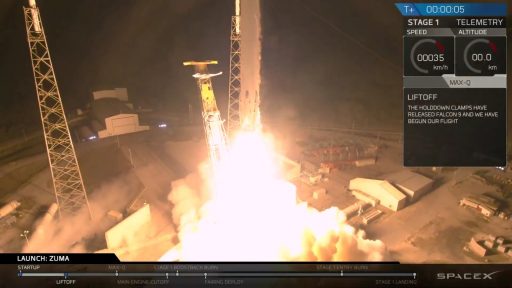
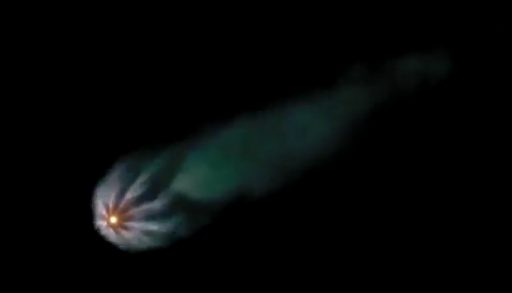
Falcon 9 soared to life at T-3 seconds with its nine Merlin 1D engines rumbling to a combined thrust of nearly 700 metric ton-force to lift the vehicle off the pad at precisely 1:00:00 UTC, the opening of the launch period. Thundering into the night, Falcon 9 pitched and rolled onto its north-easterly departure path, passing Mach 1 just over a minute into the flight and throttling down briefly when passing Maximum Dynamic Pressure at the T+76-second mark.
This mission had had a fairly short first stage burn with Main Engine Cutoff occurring two minutes and 20 seconds into the flight, right in between the NROL-76 and X-37B missions that had MECO at T+137 and T+143 seconds – providing some clues toward the total performance involved in the mission. Having accelerated the rocket to 1,673 meters per second, the first stage separated two minutes and 23 seconds after launch when the stack was 64 Kilometers in altitude.
The second stage fired up its 95,000-Kilogram-force MVac engine two seconds after staging to continue into the pre-arranged news blackout for the top-secret orbital delivery. Payload Fairing Separation was confirmed by SpaceX as the final second stage event to be reported in real time.
Per the given trajectory, the vehicle was to continue north-east across the Atlantic, arriving in orbit just before passing over Europe and reaching daylight over the Arabian Peninsula.
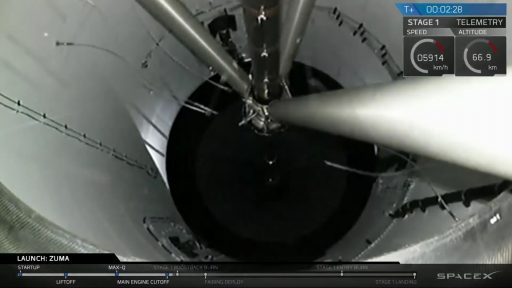
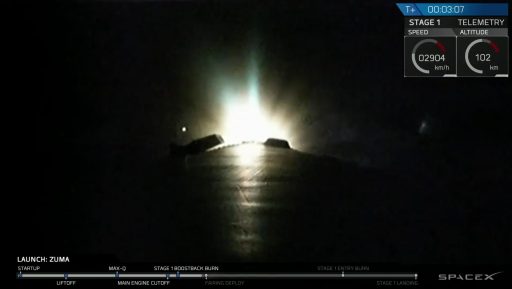
In case of a single-burn mission, Zuma and the Falcon 9 second stage would already be going separate ways when arriving over Europe; a two-burn profile into an orbit over 600km in altitude would require circularization after half an orbit of coasting; and the three-burn profile developed by Ted Molczan would see the second stage burn at 1:20 and 2:08 UTC to reach 1,000km in altitude.
Re-Entry of the second stage will occur one and a half orbits after launch with the two objects making a visible pass across Central Africa before the upper stage meets its fiery end over the Indian Ocean.
For the first stage, Block 4 Booster #1043, separation from the second stage marked the start of its speedy return to Florida. Employing its nitrogen thrusters, the booster immediately began its turn to point the engines toward the direction of travel, receiving a light toasting from the exhaust of the second stage. Mid-turn, the booster fired up its center engine at T+2:33 to accelerate the turn and begin the boost-back maneuver. When the booster was in a level orientation facing the velocity vector, two of the outer engines fired up to reverse the booster’s direction of travel and accelerate it back towards the Space Coast.
The 50-second boost back was followed by a three-minute coast phase outside the atmosphere, reaching a peak altitude of 125 Kilometers before the 47-meter long booster began falling back towards Earth, re-orienting for re-entry. The Re-Entry burn – also using a staggered engine ignition and shutdown scheme – started six minutes and 20 seconds into the flight and ran for 17 seconds, slowing the vehicle by 463 m/s.
Incredible SpaceX #Zuma launch photo by colleague @MalcolmDenemark. Launch and landing in one shot (look between the boat masts). #Falcon9 pic.twitter.com/wlowB7rUUq
— Emre Kelly (@EmreKelly) January 8, 2018
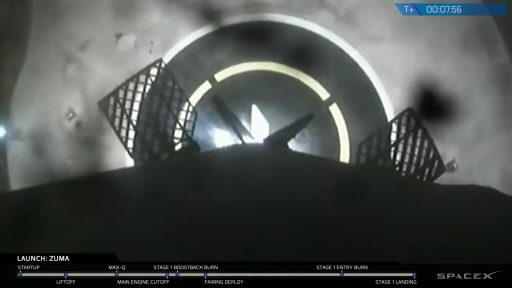
Reversing through the sound barrier, the booster relied on its four actuated grid fins to modify its angle of attack and fly out any trajectory errors during a 52-second atmospheric descent toward the landing site. Falcon 9 fired up its center engine seven minutes and 32 seconds after liftoff and entered a vertical descent into Landing Zone 1 with the four fold-out landing legs deploying just seconds before the booster came to rest. The round-trip from SLC-40 to LZ-1, located just nine Kilometers apart on the Space Coast, took seven minutes and 59 seconds.
SpaceX now has 21 successful recoveries under its belt out of 26 tries, recovering 17 different boosters after four managed to complete the feat twice. For land-based landings, SpaceX is keeping a perfect 9/9 record and Sunday night’s mission extended the company’s streak to 17 successful recoveries in a row.
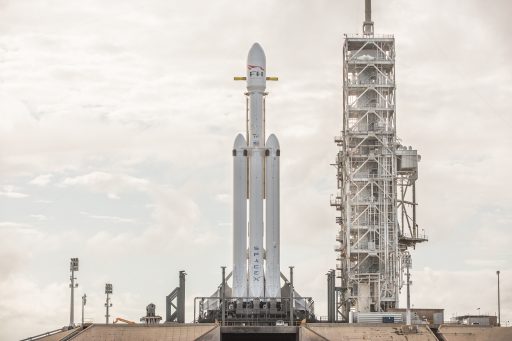
With Zuma off the pad, SpaceX can re-focus on the debut of the Falcon Heavy rocket. The tri-core vehicle spent a night standing tall at LC-39A before the year turned, completing a series of fit checks to feed into final data reviews prior to the rocket’s first Static Fire Test. The current expectation is that Falcon Heavy will return to the pad around mid-to-late week and head into a Wet Dress Rehearsal which, if no problems are encountered, will proceed into a Static Fire attempt.
Falcon Heavy’s long-awaited debut is currently set for the end of January with a tentative target of January 29 if testing and Launch Readiness Reviews are trouble-free. SpaceX’s next operational mission will involve a Falcon 9 rocket lifting the GovSat-1 (SES 16) communications satellite NET January 30 with the next mission out of Vandenberg, that had the same date as a target, understood to be slipping to the right.

